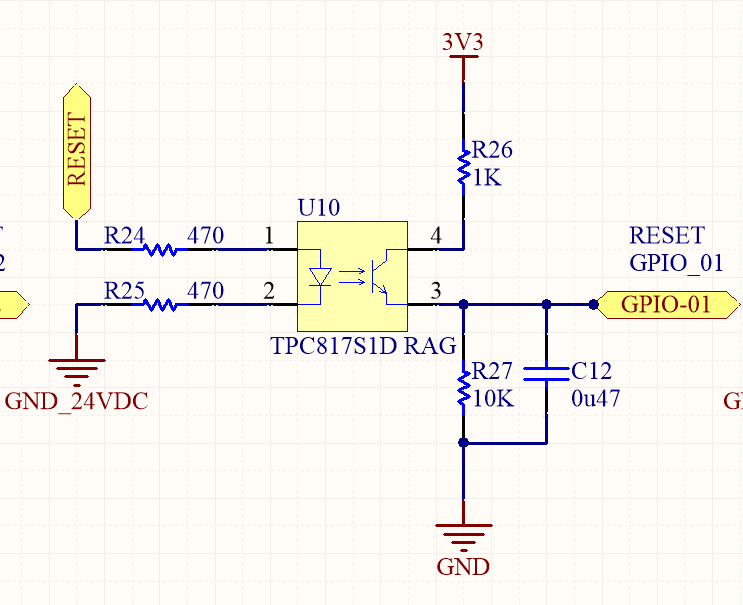Tool/software: Code Composer Studio
Hi everyone, this is Mike,
I have an issue with the ecap module and the gpio interrupts.
I'm currently using the ecap 1 (GPIO5 ) and the external interrupts (GPIO0 and GPIO1) when I press the button, doing the gpio interrupt, it seems the Timerstamp counter freezes and gives me errors in my measurements ( I'm measuring frequency with the ecap)
So, is there any kind of missing interrupt or something? Just this thing appears when I press the buttons.
Here it is the settings of both interrups, and, of course, its routine into the interrupt function.
void freq_settings(void)
{
EALLOW; //Emulación de registros
SysCtrlRegs.PCLKCR1.bit.ECAP1ENCLK = 1; // SYSCLKOUT para habilitar eCAP1
/************ Se inicia el módulo ECAP para medir el periodo y el ancho de pulso de una señal.**********/
ECap1Regs.ECEINT.all = 0; // Deshabilita todas las interrupciones del módulo eCAP
ECap1Regs.ECCTL1.bit.CAPLDEN = 0; // Deshabilita la carga de los resultados de captura
ECap1Regs.ECCTL2.bit.TSCTRSTOP = 0; // Detiene el contador
ECap1Regs.TSCTR = 0; // Limpia el contador
ECap1Regs.CTRPHS = 0; // Limpia el registro de contador de fase
ECap1Regs.ECCTL2.bit.CAP_APWM = 0; // Modo Captura
ECap1Regs.ECCTL2.bit.SWSYNC = 0; // Sincronización forzada Deshabilitada
ECap1Regs.ECCTL2.bit.SYNCO_SEL = 10; // Syncin = Syncout, requerido por SWSYNC
ECap1Regs.ECCTL2.bit.SYNCI_EN = 0 ; // Habilita sincronización de entrada
ECap1Regs.ECCTL2.bit.TSCTRSTOP = 1; // Time Stamp Counter free-running
ECap1Regs.ECCTL2.bit.REARM = 0; // No Re-arme (Re-arme ->arma una secuencia de captura predeterminada)
ECap1Regs.ECCTL2.bit.STOP_WRAP = 11; // Toma 4 capturas en modo continuo
ECap1Regs.ECCTL2.bit.CONT_ONESHT = 0; // Operando en modo continuo
ECap1Regs.ECCTL1.bit.FREE_SOFT= 11; // Time Stamp Counter no es afectado por le emulación suspendida
ECap1Regs.ECCTL1.bit.PRESCALE = 00000; // Dividido entre 1
ECap1Regs.ECCTL1.bit.CAPLDEN = 1; // Habilita los registros de carga CAP1-4 en un evento
ECap1Regs.ECCTL1.bit.CTRRST4 = 0; // Sin reset en la primera captura
ECap1Regs.ECCTL1.bit.CAP4POL = 1; // Captura en el ascenso de la señal
ECap1Regs.ECCTL1.bit.CTRRST3 = 0; // Sin reset en la segunda captura
ECap1Regs.ECCTL1.bit.CAP3POL = 0; // Captura en el descenso de la señal
ECap1Regs.ECCTL1.bit.CTRRST2 = 0; // Sin reset en la tercera captura
ECap1Regs.ECCTL1.bit.CAP2POL = 1; // Captura en el ascenso de la señal
ECap1Regs.ECCTL1.bit.CTRRST1 = 0; // Sin reset en la cuarta captura
ECap1Regs.ECCTL1.bit.CAP1POL = 0; // Captura en el descenso de la señal
/****************************************************************************************************/
/************ Interrupciones del ECAP ****************/
PieVectTable.ECAP1_INT = &freq_isr; // El contenido del subprograma de interrupción "ecap_isr" es copiado por el subprograma de interrupción "ECAP1_INT" contenido en la tabla.
ECap1Regs.ECEINT.all = 0x0008; // Habilita las interrupciones
PieCtrlRegs.PIEIER4.bit.INTx1 = 1; // Habilita la interrupción de ECAP1_INT en PIE grupo 4
IER |= 0x0008; // Habilita INT4 en IER para habilitar el grupo 4 del bloque de interrupciones
EINT;
ERTM;
/******************************************************/
/*********** Configuración del pin de entrada para el ECAP *********/
GpioCtrlRegs.GPACTRL.all = 0x00000000;
GpioCtrlRegs.GPAMUX1.bit.GPIO5 = 3; // GPIO 5 Configurado para captura de pulsos
GpioCtrlRegs.GPADIR.bit.GPIO5 = 0; // GPIO 5 como entrada
//GpioCtrlRegs.GPAPUD.bit.GPIO5 = 0; // Pull-up habilitado para GPIO5 (0)
/* GpioCtrlRegs.GPAMUX2.bit.GPIO24 = 1; // GPIO 5 Configurado para captura de pulsos
GpioCtrlRegs.GPADIR.bit.GPIO24 = 0; // GPIO 5 como entrada
GpioCtrlRegs.GPAPUD.bit.GPIO24 = 0; // Pull-up habilitado para GPIO5 (0)*/
/*****************************************************************/
EDIS; // Deshabilita la emulación de registros
}
void reset_stop_inhibit_settings(void)
{
EALLOW;
PieVectTable.XINT1 = &reset_isr; // El contenido del subprograma de interrupción "reset_isr" es copiado por el subprograma de interrupción "XINT1" contenido en la tabla.
PieVectTable.XINT2 = &emergency_stop_isr; // El contenido del subprograma de interrupción "emergency_stop_isr" es copiado por el subprograma de interrupción "XINT2" contenido en la tabla.
PieVectTable.XINT3 = &inhibit_isr; // El contenido del subprograma de interrupción "inhibit_isr" es copiado por el subprograma de interrupción "XINT3" contenido en la tabla.
PieCtrlRegs.PIECTRL.bit.ENPIE = 1; // Habilita el bloque de Puerto Expandido de Interrupciones
PieCtrlRegs.PIEIER1.bit.INTx4 = 1; // Habilita el PIE grupo 1 INT 4 para XINT1, consultar spruh18g.pdf pag 176-177
PieCtrlRegs.PIEIER1.bit.INTx5 = 1; // Habilita el PIE grupo 1 INT 1 para XINT5, consultar spruh18g.pdf pag 176-177
//PieCtrlRegs.PIEIER12.bit.INTx1 = 1; // Habilita el PIE grupo 12 INT 1 para XINT3, consultar spruh18g.pdf pag 176-177
IER |= M_INT1; // Habilita interrupciones del CPU 1
//IER |= M_INT12; // Habilita interrupciones del CPU 12
EINT; // Habilita interrupciones globales
EDIS;
EALLOW;
/* STOP */
GpioCtrlRegs.GPAMUX1.bit.GPIO0 = 0; // GPIO0 como Digital I/O, no funciones especiales
//GpioDataRegs.GPACLEAR.bit.GPIO0 = 1; // Limpia registro GPIO0
GpioCtrlRegs.GPADIR.bit.GPIO0 = 0; // GPIO0 como entrada
GpioCtrlRegs.GPAQSEL1.bit.GPIO0 = 0; // XINT1 sincronizado al reloj del sistema solamente
/* RESET */
GpioCtrlRegs.GPAMUX1.bit.GPIO1 = 0; // GPIO1 como Digital I/O, no funciones especiales
//GpioDataRegs.GPACLEAR.bit.GPIO1 = 1; // Limpia registro GPIO01
GpioCtrlRegs.GPADIR.bit.GPIO1 = 0; // GPIO01 como entrada
GpioCtrlRegs.GPAQSEL1.bit.GPIO1 = 0; // XINT2 Qual usa 6 muestras
//GpioCtrlRegs.GPACTRL.bit.QUALPRD0 = 0xFF; // Cada ventana de muestreo es 510 veces el reloj del sistema (510*SYSCLKOUT)
// INHIBIT
//GpioCtrlRegs.GPBMUX1.bit.GPIO32 = 0; // GPIO32 como Digital I/O, no funciones especiales
//GpioDataRegs.GPBCLEAR.bit.GPIO32 = 1; // Limpia registro GPIO32
//GpioCtrlRegs.GPBDIR.bit.GPIO32 = 1; // GPIO32 como entrada
//GpioCtrlRegs.GPAQSEL2.bit.GPIO32 = 0; // XINT1 sincronizado al reloj del sistema solamente
EDIS;
// GPIO0 es XINT1, GPIO1 es XINT2
EALLOW;
GpioIntRegs.GPIOXINT1SEL.bit.GPIOSEL = 0; // XINT1 es GPIO0 (STOP)
GpioIntRegs.GPIOXINT2SEL.bit.GPIOSEL = 1; // XINT2 es GPIO1 (RESET)
//GpioIntRegs.GPIOXINT3SEL.bit.GPIOSEL = 32; // XINT3 is GPIO1 (INHIBIT)
// Configuración de XINT1 y XINT2
XIntruptRegs.XINT1CR.bit.POLARITY = 1; // Interrupción en el flanco positivo
XIntruptRegs.XINT2CR.bit.POLARITY = 1; // Interrupción en el flanco negativo
//XIntruptRegs.XINT3CR.bit.POLARITY = 1; // Interrupción en el flanco positivo
// Habilitar XINT1 y XINT2
XIntruptRegs.XINT1CR.bit.ENABLE = 1; // Habilita XINT1
XIntruptRegs.XINT2CR.bit.ENABLE = 1; // Habilita XINT2
// XIntruptRegs.XINT3CR.bit.ENABLE = 1; // Habilita XINT3
EDIS;
}
__interrupt void
freq_isr(void)
{
// Calcula el ciclo de trabajo (flanco ascendente a flanco descendente)
// PwmDuty = (int32)ECap1Regs.CAP2 - (int32)ECap1Regs.CAP1;
// Calcula el periodo (flanco ascendente a flanco ascendente)
PwmPeriod = (int32)ECap1Regs.CAP3 - (int32)ECap1Regs.CAP1;
Periodo = (PwmPeriod/90401640.0);
Frecuencia = 1/Periodo;
ECap1Regs.ECCLR.bit.CEVT3 = 1; // Limpia la bandera de CEVT3
ECap1Regs.ECCLR.bit.INT = 1; // Limpia l bandera de interrupción de ECAP1
PieCtrlRegs.PIEACK.all = PIEACK_GROUP4; // Debe reconocer el grupo PIE
}
__interrupt void reset_isr(void)
{
if(flag_emergency_break_on == TRUE)
{
flag_emergency_break_on = FALSE;
}
PieCtrlRegs.PIEACK.all = PIEACK_GROUP1;
}
__interrupt void emergency_stop_isr(void)
{
flag_emergency_break_on = TRUE;
PieCtrlRegs.PIEACK.all = PIEACK_GROUP1;
}


